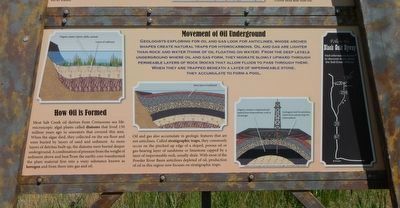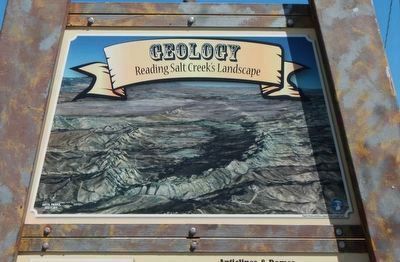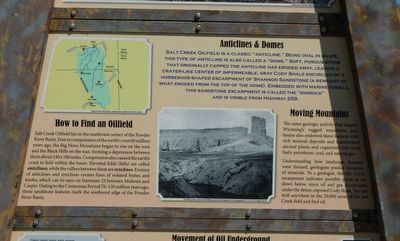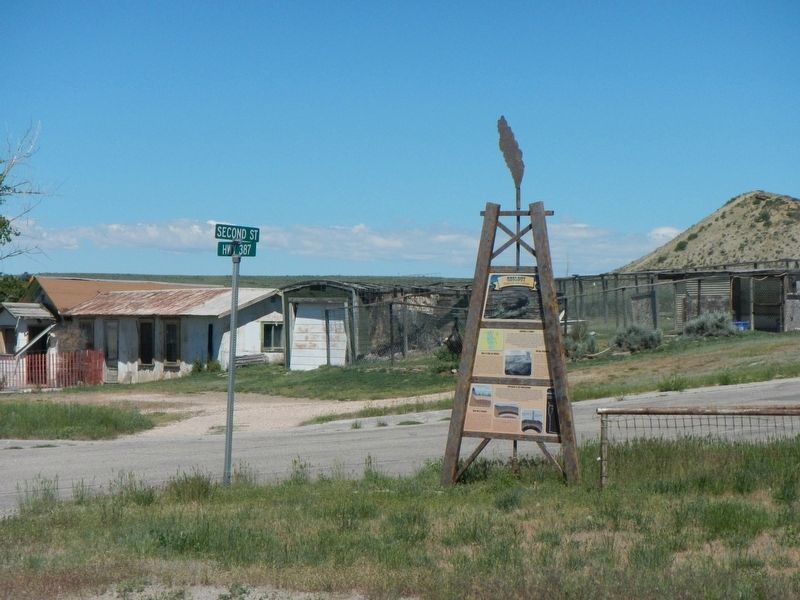Edgerton in Natrona County, Wyoming — The American West (Mountains)
Geology
Reading Salt Creek's Landscape
Inscription.
(top panel:) no text
(middle panel:)
Salt Creek Oilfield is a classic “anticline.” Being oval in shape, this type of anticline is also called a “dome.” Soft, porous stone that originally capped the anticline has eroded away, leaving a crater-like center of impermeable, gray Cody Shale encircled by a horseshoe-shaped escarpment of Shannon Sandstone (a remnant of what eroded from the top of the dome). Embedded with marine fossils, this sandstone escarpment is called the “rimrock” and is visible from Highway 259.
How to find and Oilfield
Salt Creek Oilfield lies in the southwest corner of the Powder River Basin. Due to compression of the earth’s crust 60 million years ago, the Big Horn Mountains began to rise on the west and the Black Hills on the east, forming a depression between them about 250x100 miles. Compression also caused the earth’s crust to fold within the basin. Elevated folds (hills) are called anticlines, while the valley between them are synclines. Erosion of anticlines and synclines creates lines of isolated buttes and knobs, which can be seen on Interstate 25 between Midwest and Casper. Dating to the Cretaceous Period 70-130 million years ago, these sandstone features mark the southwest edge of the Powder River Basin.
The same geologic activity that shaped Wyoming’s rugged mountains and basins also endowed these features with rich mineral deposits and transformed ancient plants and organisms into fossil fuels: petroleum, coal, and natural gas. Understanding how landscape features were formed, geologists predict locations of minerals. To a geologist, the Salt Creek escarpment indicates possible pools of oil down below, since oil and gas accumulate under the dense, exposed Cody Shale. You can drill anywhere in the 20,000 acres of the Salt Creek field and find oil.
(bottom panel:)
Geologists exploring for oil and gas look for anticlines, whose arched shapes create natural traps for hydrocarbons. Oil and gas are lighter than rock and water (think of oil floating on water). From the deep levels underground where oil and gas form, they migrate slowly upward through permeable layers of rocks (rocks that allow fluids to pass through them). When they are trapped beneath a layer of impermeable stone, they accumulate to form a pool.
Most Salt Creek oil derives from Cretaceous sea life: microscopic algal plants called diatoms that
lived 150 million years ago in seawaters that covered this area. When the algae died, they collected on the sea floor and were buried by layers of sand and sediment. As more layers of detritus built up, the diatoms were buried deeper underground. A combination of pressure from the weight of sediment above and heat from the earth’s core transformed the plant material first into a waxy substance known as kerogen and from there into gas and oil.
Oil and gas also accumulate in geologic features that are not anticlines. Called stratigraphic traps, they commonly occur on the pinched-up edge of a sloped, porous oil or gas-bearing layer of sandstone or limestone capped by a layer of impermeable rock, usually shale. With most of the Powder River Basin anticlines depleted of oil, production of oil in this region now focuses on stratigraphic traps.
Erected by Wyoming State Parks and Cultural Resources.
Topics. This historical marker is listed in this topic list: Natural Resources.
Location. 43° 24.948′ N, 106° 14.821′ W. Marker is in Edgerton, Wyoming, in Natrona County. Marker is at the intersection of North Second Street and Wyoming Highway 387, on the right when traveling north on North Second Street. Touch for map. Marker is at or near

Photographed By Barry Swackhamer, June 5, 2016
3. Geology Marker, bottom panel
Captions: How oil is formed; (upper left) Organic matter: plants, shells, animals; Layers of sediment.; (center) More layers of sediment; (bottom right) Organic remains compressed and heated form hydrocarbons, such as oil and gas. Geologists look for anticlines which form natural traps for hydrocarbons.; Formation of oil from orgainic mater (left and center) Oil trap (right); (far right) Map of the Black Gold Byway kiosks.
Other nearby markers. At least 8 other markers are within 7 miles of this marker, measured as the crow flies. Gushers, (approx. 1.2 miles away); Salt Creek Oil Field (approx. 1.2 miles away); a different marker also named Salt Creek Oil Field (approx. 1½ miles away); Oil Boom Towns (approx. 1½ miles away); Midwest Veterans Memorial (approx. 1½ miles away); Society in an Oil Patch (approx. 1½ miles away); a different marker also named Salt Creek Oil Field (approx. 7.1 miles away); Scandal! (approx. 7.1 miles away).
More about this marker. This marker is a part of the Black Gold Byway series.
Credits. This page was last revised on July 5, 2016. It was originally submitted on July 5, 2016, by Barry Swackhamer of Brentwood, California. This page has been viewed 396 times since then and 12 times this year. Photos: 1, 2, 3, 4. submitted on July 5, 2016, by Barry Swackhamer of Brentwood, California.


